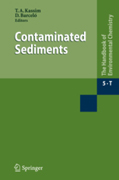
When discussing the issue of contamination of the aquatic environment, water pollution is still the major aspect that has been regulated and extensively studied, but poor attention has been devoted to sediments. Sediments have been described as the sink or storage place and a source for contaminants entering river systems through various pathways. But bottom sediments have various functions in the environment, such as providing habitat for many aquatic organisms,and are an important component of aquatic ecosystems. This volume of the Handbook deals with various aspects of sediment contamination such as the fate andbehavior of persistent organic pollutants, the application of sediment toxicity identification evaluation (TIE) protocols, and the various ways to degrade toxic pollutants from sediments. Overall the book provides readers the fundamental knowledge needed to better understand the complex issue of contaminated sediments. INDICE: K. Ho: Development and Application of Toxicity Identification Evaluations for Contaminated Sediments.- J. Cairns: The Influence of Contaminated Sediments on Sustainable Use of the Planet.- W.J. Catallo: Biogeochemical Transformation of Contaminants in Contaminated Sediments.- R.M.M. Abed: Modern Molecular Techniques: Excellent Tools to study Diversity and Activity of Bacterial Communities in oil-contaminated Sediments.- D.D. Reible: Steady State Model of Chemical Migration in a Sediment Cap.- E. Eljarrat and D. Barcelo: Chlorinated and Brominated Organic Pollutants in Contaminated River Sediments.
- ISBN: 978-3-540-88013-4
- Editorial: Springer
- Encuadernacion: Cartoné
- Páginas: 180
- Fecha Publicación: 01/01/2009
- Nº Volúmenes: 1
- Idioma: Inglés
